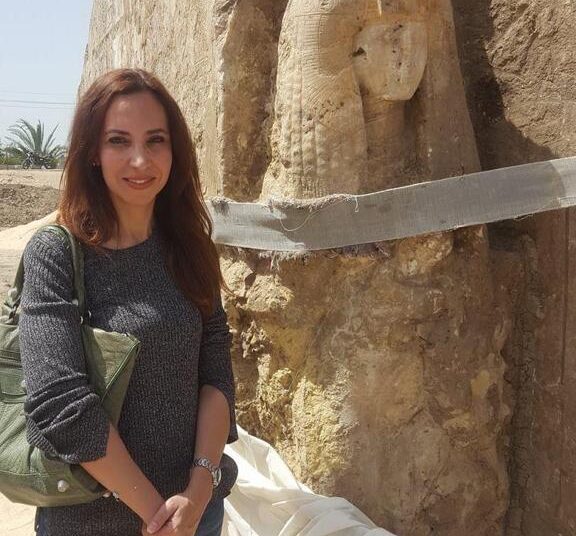Yasmine el-Shazly has been obsessed with Egyptian history since she was a high school pupil.
Such an obsession filled her with curiosity to know more about her ancestors’ life and civilisation.
She was, however, one of few people who succeeded in turning their passion into action by creating one milestone after another in Egyptology.
In this, she is blazing a trail for other women in this field.
El-Shazly shares some of the secrets of her career journey, one filled with achievements, in this interview with the Egyptian Mail.
“If there is anything I want to teach people, it will be that flexibility is always an important key of success,” el-Shazly said.
El-Shazly is one of those unsung heroes who help people understand human history.
Egyptology is far from appealing to many women. It is about excavations and digging for the traces of those who departed life hundreds, and, may be, thousands of years ago.
Nonetheless, El-Shazly insisted to embark on a career journey as an Egyptologist.
She graduated from the American University in Cairo (AUC) and now she is the Deputy Director of Research and Programmes at the American Research Centre in Egypt.
She is also an adjunct assistant professor of Egyptology at the AUC.
She was the head of the Department of International Organisations of Cultural Heritage and International Co-operation at the Ministry of Tourism and Antiquities.
El-Shazly was apprenticed by renowned Egyptologist and archaeologist, Zahi Hawass, at an early stage.
She is filled, she said, with gratefulness to this man.
“He pushed me forward all the time,” el-Shazly said.

After graduating from university, el-Shazly enrolled at the Johns Hopkins University in Baltimore, Maryland, to make her master’s degree and PhD.
She said she took part in excavations since she was a university student.
“I studied Near East archaeology as well,” el-Shazly said. “This was why I worked in places as far as Syria.”
As an undergraduate, el-Shazly went to the Valley of the Kings, particularly its famous KV55 tomb, something she remembers vividly.
After returning from the US, el-Shazly worked for the Museum of Egyptian Antiquities in downtown Cairo.
She was involved in a project of the American Research Centre on the registration and the documentation of antiquities and artifacts.
“We created a database for the museum, one that contains a record of all contents in the place,” el-Shazly said.
El-Shazly and her team also played an important role in the recovery of some of the artifacts that were looted from the museum during the January 25, 2011 uprising.
They started the recovery process by preparing a list of all the pieces that disappeared from the museum at the time.
The team then sent this list to all authorities, along with International Police.
“This helped us recover many antiquities that were smuggled outside Egypt at the time,” she said with pride.
El-Shazly believes each excavation mission is different from the other.
She went to Syria in 2002, but this was one of her hardest stints.
“I was suddenly in the middle of nowhere,” el-Shazly said.
She was sent to an area in the Syrian countryside where there were no phones or any other communication tools with the outside world.
“My colleagues and I stayed for two months in this area,” el-Shazly said.
They woke up at 4:00 a.m. every day, cooked their food and relied on the few tools they had.
Most of those around el-Shazly tried to dissuade her from going to Syria, a mission that was filled with difficulties.
Nonetheless, adventurous as always, she insisted to go to be part of this experience.

El-Shazly usually oversees the work of junior excavators and diggers during the different missions.
This is a job, she said, that requires accuracy and alertness.
“We do not dig randomly,” she said. “I always tell the diggers where exactly to dig.”
Diggers usually dig 15 centimetres in the initial stage. They then dig another 15 centimetres before they measure where they are from the sea level.
Each digging level, el-Shazly said, can belong to a specific historical era.
When the diggers unearth artifacts, el-Shazly hurries to document them.
Despite all hardships, el-Shazly cannot think of any bitter memories in relation to her work.
She remembers the conference and exhibition ‘Exalted Spirits: The Veneration of the Dead in Egypt through the Ages’ with fondness.
This event, organised by the American Research Centre in Egypt, the AUC and the Ministry of Tourism and Antiquities, was held between November 9 last year and February 9 this year.
The event was special to el-Shazly’s heart because she is obsessed with veneration of the dead.
“This was why this event was very special to me,” el-Shazly said.
She believes that ancient Egypt and present-day Egypt are one and the same thing.
“The conference was not only about ancient Egypt, but also about all periods in Egyptian history,” el-Shazly said.
The conference covered the issue of venerating the dead throughout Egyptian history.
Conference speakers used diverse proofs to prove their view, including texts, images, and traditions.
El-Shazly called for teaching Egyptian history in an attractive and more interactive manner.
“We have to make school pupils feel that the historical figures they read about in their textbooks were real people like us,” el-Shazly said.
“This can be done if the study focuses on the daily life of those who lived a long time ago,” she added.
She said she cannot but admire young Egyptians who opt for Egyptology as a career path.
She met some of these people.
“They are goal-oriented, persistent and ambitious,” she said.
Despite her courage, adventurous nature and professional record, el-Shazly believes working women face biological challenges.
For instance, she said, when a woman gives birth, she has to stop working for a while.
“Even with this, I still believe women’s progress cannot be hindered,” el-Shazly said confidently. “Women have to view themselves as they really are: human beings who have to keep struggling to overcome all challenges.”




